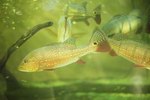Water filtration in aquariums is accomplished with various methods. Compatible with two types of filters, a spray bar is a plastic attachment that looks a little like a flute. The spray bar spreads water evenly, onto either the surface of the water or onto filter media.
What's Under the Hood
Filter media are primary components of any filtration system. Generally filter systems incorporate three types of filter media in their construction:
- Biological filtration converts toxins such as ammonia into less harmful gases.
- Chemical filtration further purifies water from chemicals through activated charcoal.
- Mechanical filtration physically strains debris, waste and organics from the water.
Tips
The "bioload," or biological load, of an aquarium refers to the amount of life -- including plants and invertebrates -- living in one tank. Bioloads are measured in levels of ammonia, nitrite and nitrate in the tank, and are an important factor in selecting which filtration system is right for you and your fish.
Yes It Canister
Canister filters remove water from a tank via a tube and force it through one or more filter media. When the filtered water comes out of the canister, it will be returned to the tank via a spray bar, if one is utilized. If the canister filter has no spray bar, the water will simply spill into the tank in one spot, like a waterfall.
Using a spray bar reduces evaporation and can modulate water current. Canister filters are ideal for medium-size to large tanks, as the pressure-driven filtration systems are equipped to handle large amounts of water efficiently.
Warnings
There is no one perfect filtration system: The right system for you depends upon your aquarium's bioload and physical size. When in doubt, check with a local aquatic specialist to provide the healthiest environment for your fish.
Trickle Treat
The other filtration method that utilizes spray bars is the trickle filter. Trickle filters depend upon an overflow of water to remove dirty water from the aquarium. When the overflow threshold is reached -- and this varies from tank to tank -- water flows through a collection drain and is distributed over the filter media.
Unlike with a canister filter, the spray bar comes into play before the water is filtered, not after. Instead of spraying filtered water over the surface of the tank, it sprays dirty water evenly over filter media. The filtered water is then collected in a reservoir called a sump, and pumped back into the tank. Sometimes the water is distributed via a drip tray or a "spinner," simply a spray bar that rotates.
Spray It Don't Pay It
Spray bars are generally adjustable, and they can be customized to control spray direction, level of output and strength of pressure. As with other parts of your aquarium setup, you will need to clean your periodically to keep it from developing mold, bacteria or a buildup of debris. Without proper upkeep, a spray bar or filter can fail, costing you not just replacement parts but also, potentially, your fish.





